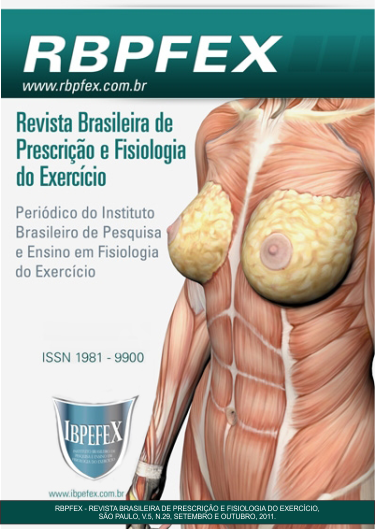Correlation between the use of 5-HT agonist drug and aerobic physical exhaustion
Abstract
Introduction: Works of different authors has been shown that, an increase in the concentration of serotonin (5-HT) in the brain during intense and long-term physical exercise, is directly related with a harm in the function of the Central Nervous System (CNS), with corresponding development of the fatigue and consequence decrease of the performance. Materials and methods: Ten rats Wistar was submitted the run-sessions until the exhaustion in treadmill. The experimental protocol consisted in the evaluation of the range run-time of the animals until the exhaustion, divides in three weekly sessions in alternates days. The animals were treated, during seven days, with agonist drug 5-HT, fluoxetine, (10mg/kg/day) dissolved in physiologic solution (NaCl 0,9%) injected intraperitoneally (i.p.). Results: It was observed that the average run time of the animals to exhaustion increased significantly. Conclusion: The present study suggest that the chronicle administration (12 days) of fluoxetine in the dose of 10 mg/kg/day (i.p.) increase substantially the run-time until the exhaustion in rats submitted the exercises in treadmill.
References
-Bailey, S.P.; Davis, J.M.; Ahlborn, E.N. Effect of increased brain serotonergic (5-HT1c) activity on endurance performance in the rat. Acta Physiologica Scandinavica, San Francisco, Vol. 145. 1992. p. 76-77.
-Bailey, S.P.; Davis J.M.; Ahlborn, E.N. Serotonergic agonists and antagonists affect endurance performance in the rat. International Journal of Sports Medicine, New York, Vol. 14. 1993. p. 330-333.
-Chaouloff, F. Effects of acute physical exercise on central serotonergic systems. Medicine and Science in Sports and Exercise, Madison, Vol. 29. Num. 1. 1997. p. 58-62.
-Davis, J.M.; Bailey, S.P. Possible mechanisms of central nervous system fatigue during exercise. Medicine and Science in Sports and Exercise, Madison, Vol. 29, Num. 1, p. 45-57, 1997.
-Davis, J.M.; Alderson, N.L.; Welsh R. Serotonin and central nervous system fatigue: nutritional considerations. American Journal of Clinical Nutrition, Bethesda, Vol. 72, (suppl)57, p. 3-8, 2000.
-Dantas, E.H. A prática da preparação física. Rio de Janeiro: Shape, 2003.
-Halford, J.C.; Harrold, J.A.; Lawton, C.L.; Blundell, J.E. Serotonin (5-HT) drugs: effects on appetite expression and use for the treatment of obesity. Current Drug Targets, Notre Dame, Vol. 6, Num. 2, p. 201-213, 2005.
-Hjorth, S. Hypothermia in the heat induced by the potent serotonergic agent 8-OH-DPAT. Journal of Neural Transmission, New York, Vol. 61, Num. 1-2, p. 671-677, 1985.
-Hoomann, W.; Struder, H.K. Exercise, physical activity, nutrition, and the brain.Nutrition Reviews, Washington, Vol. 54, p. 37-43, 1996.
-Meeusen, R.; Piacentrini, M.F.; Van Den Eynde, S.; Magnus, L; De Meirleir, K. Exercise performance is not influenced by a 5-HT reuptake inhibitor. Sports Medicine, Auckland, Vol. 22, Num. 3, p. 29-36, 2001.
-Muck-Seller, D.; Jevric-Causevic, A.; DIKSIC, M. Influence of fluoxetine on regional serotonin synthesis in the rat brain. Journal of Neurochemistry, Washington, Vol. 67, Num. 2, p. 434-442, 1996.
-Newsholme, E.A; Blomstrand, E. Tryptophan, 5-hydroxytryptamine and a possible explanation for central fatigue. Advances in Experimental Medicine and Biology, Heidelberg Vol. 384, p. 315-320, 1995.
-Rossi, L.; Tirapegui, J.O. Aminoácidos: bases atuais para sua suplementação na atividade física. Revista Brasileira de Ciências Farmacêuticas, São Paulo, Vol. 36. Num. 1. p. 37-51. 2000.
-Rossi, L.; Tirapegui, J.O. Implicações do sistema serotoninérgico no exercício físico. Arquivos Brasileiros de Endocrinologia e Metabologia, São Paulo, Vol. 48. Num. 2. p. 227-233. 2004.
-Strachan, A.T.; Leiper, J.B.; Maughan, R.J. Serotonin2c receptor blockade and thermoregulation during exercise in the heat. Medicine and Science in Sports and Exercise, Madison, Vol. 37, Num. 3, p. 389-394, 2005.
-Wearden, A.J.; Morris, R.K.; Mullis, R.; Strickland, P.L.; Pearson, D.J.; Appleby, L., Campbell, I.T.; Morris, J.A. Randomised, double-blind, placebo-controlled treatment trial of fluoxetine and graded exercise for fatigue syndrome. British Journal of Psychiatry, London, Vol. 172, p. 485-490, 1998.
-Wong, D.T.;Threlkeld, P.G.; Robertson, D.W. Affinities of fluoxetine its enantiomers and other inhibitors of serotonin uptake for subtypes of serotonin receptors. Neuropsychopharmacology, New York, Vol. 5. Num. 1. p. 43-47, 1991.
Authors who publish in this journal agree to the following terms:
- Authors retain the copyright and grant the journal the right of first publication, with work simultaneously licensed under the Creative Commons Attribution License BY-NC which allows the sharing of the work with acknowledgment of the authorship of the work and initial publication in this journal.
- Authors are authorized to enter into additional contracts separately for non-exclusive distribution of the version of the work published in this journal (eg, publishing in institutional repository or book chapter), with acknowledgment of authorship and initial publication in this journal.
- Authors are allowed and encouraged to post and distribute their work online (eg, in institutional repositories or on their personal page) at any point before or during the editorial process, as this can bring about productive change as well as increase impact and impact. citation of published work (See The Effect of Free Access).






